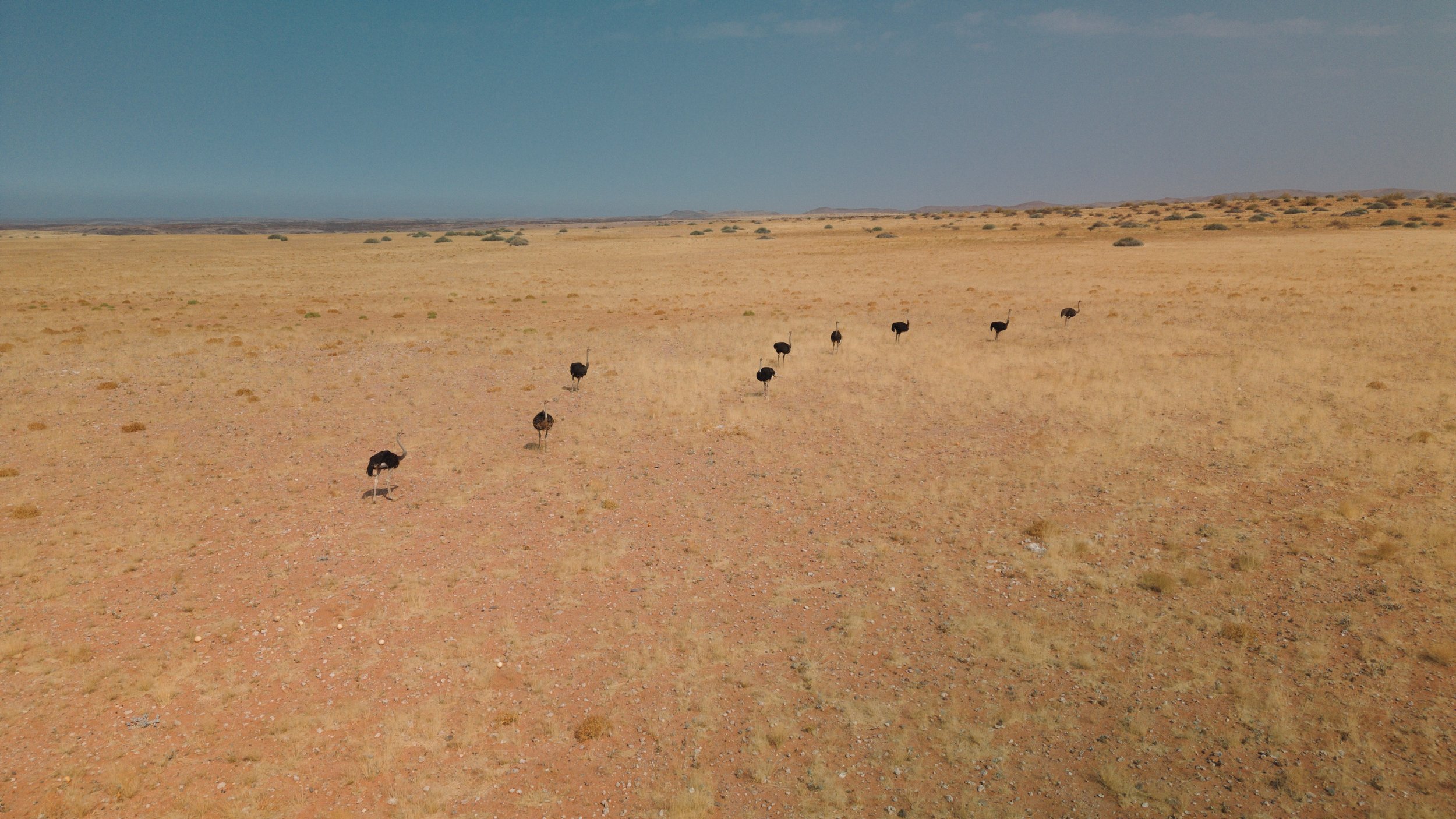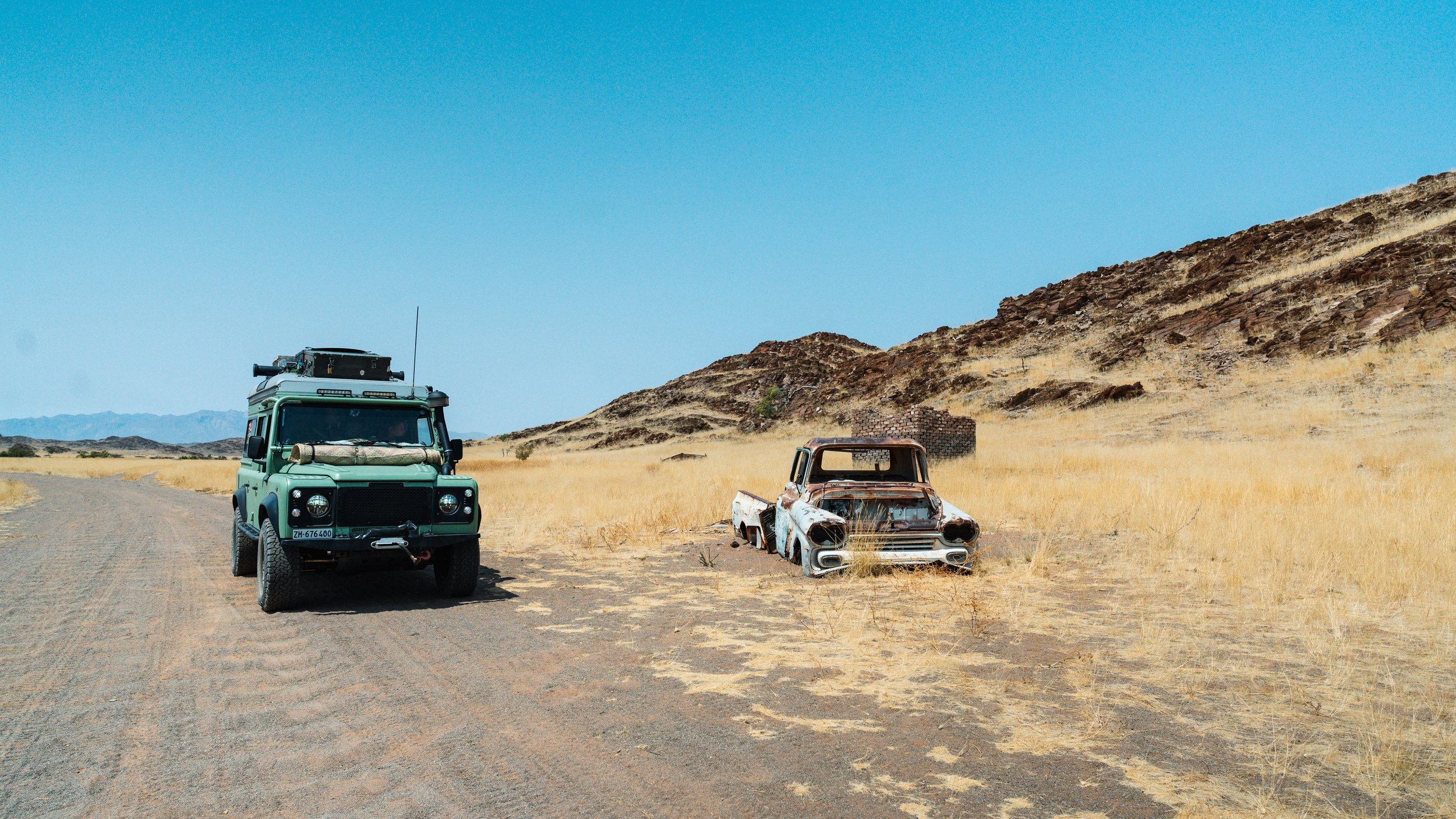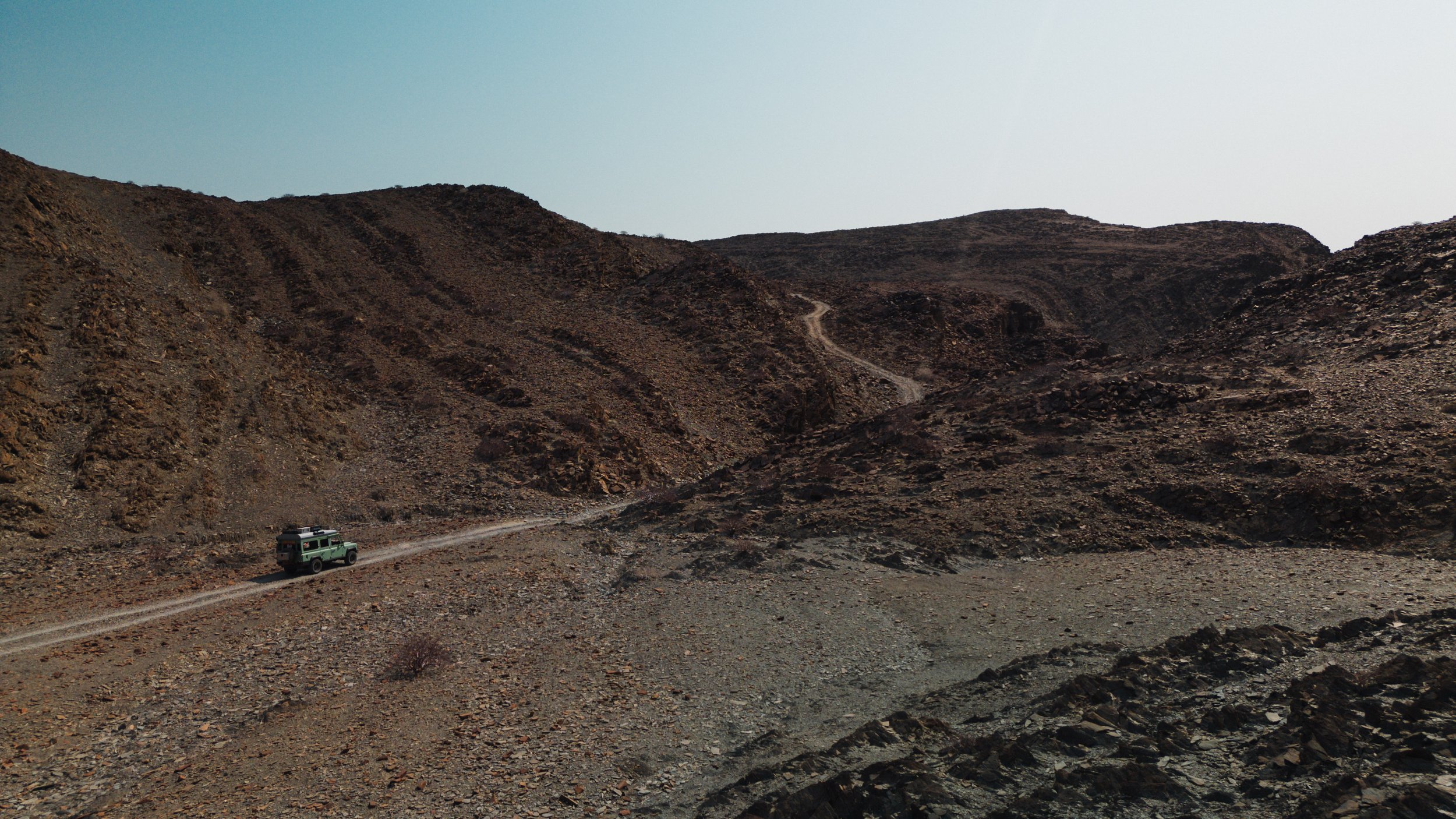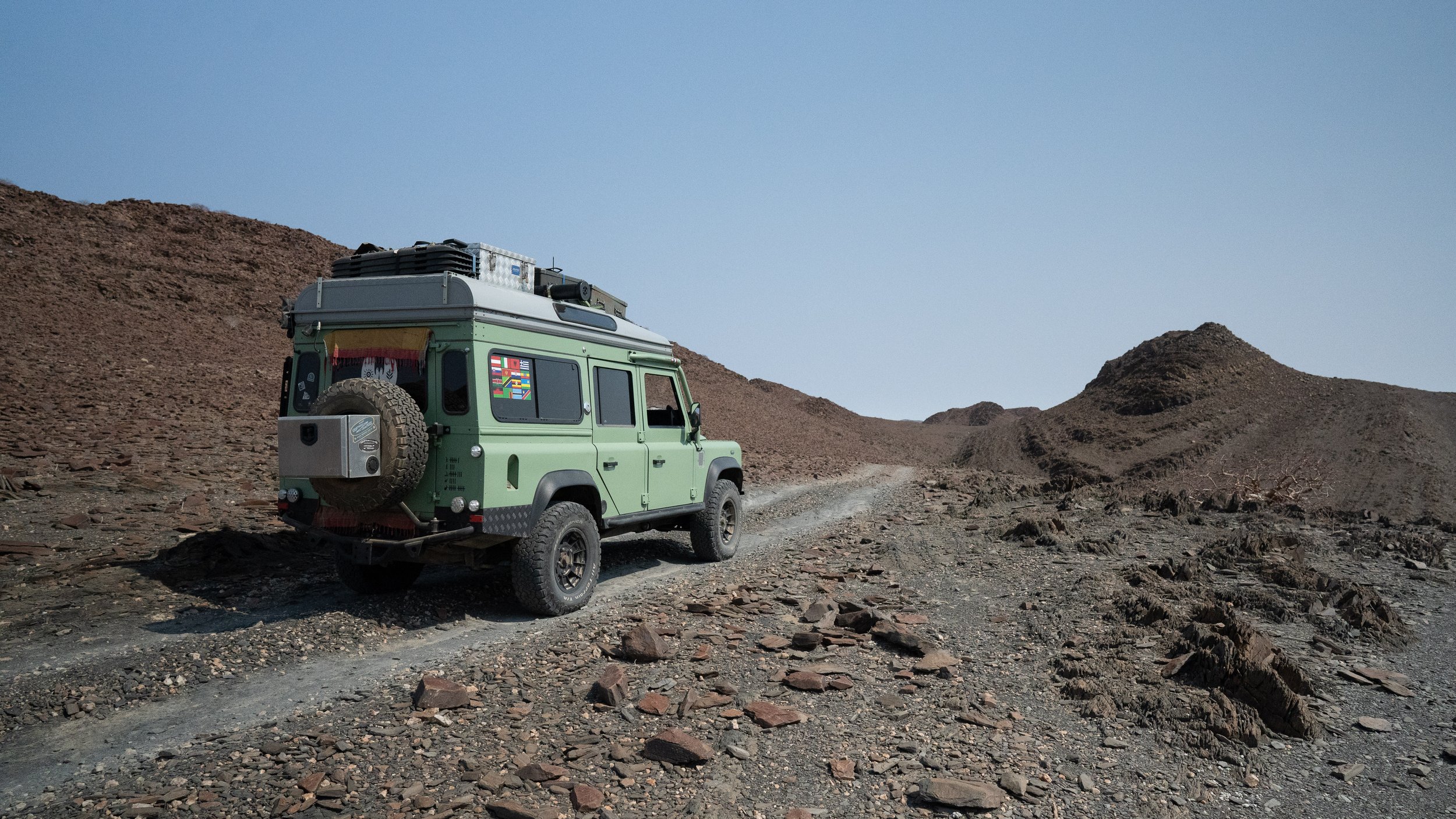We had only a few kilometers left in Cameroon before we would reach the border to Nigeria, but ahead of us was the trickiest part of the whole route from South to North along the West Coast of Africa. Cameroon and Nigeria are huge countries facing different political challenges and instabilities. Unfortunately, this also leads to security issues due to rebel groups that hide in the mountains. For tourists, there is only one border post open, which means that everyone has to take the dirt track from Banyo in Cameroon to Gembu in Nigeria or the other way, and it’s a track that requires a good 4x4 vehicle and some high ground clearance. Overlanders who don’t have such a car have to ship around. Our timing wasn’t ideal either since it was the beginning of the rainy season. But our Defenders are well equipped and being two cars also gives a lot of security. From the hotel in Magba, where we spent the night, we drove to Banyo in one day. It was the first stretch on dirt roads, and we were not as fast anymore as when we could drive on tar roads. We only managed to drive 86 kilometers in a day, but on the bright side, the route was very scenic, and the weather stayed dry, so we enjoyed the drive through the Cameroon Highlands a lot. Just before we reached Banyo, some dark clouds appeared ahead of us; a big thunderstorm was building up. The minute we arrived at the spot where we wanted to spend the night, it started pouring down. It was a heavy short shower, and the lightning passed us in the distance while we were sitting in our cars to wait for the storm to pass. Luckily, after only 15 minutes, the sky cleared up again, and we could set up our camp. Some friendly visitors from town, who saw us driving here, came to say hi. We cooked spaghetti carbonara and then went to bed, hoping the road would dry until the next day.
We drove into the small town of Banyo early in the morning to fill up our tanks and change money because this was the last town on our way to Nigeria. Unfortunately, there was no diesel at the Petrol Station, but we found someone who sold us some jerrycans - for double the price, but at least we could fill up our tanks.
We left Banyo and started on the muddy track. The rain from last night soaked the roads, and after only a couple of hundred meters, we saw the first car stuck. Luckily, our Defenders were driving very smoothly through the mud. Some other cars struggled more, and once, we even had to pull another vehicle out after they couldn’t get out of the mud anymore. We continued slowly; luckily, the track dried out quickly in the sun. Without any major issues, we managed to drive the whole way to the border of Nigeria. We enjoyed this track a lot, and the scenery was just stunning.
The border crossing into Nigeria was relatively easy. That’s a big advantage of taking small, remote borders; usually, they are quite fast to cross. We reached the town of Maya Ndaga just in time before it got dark. In 12 hours, we drove around 70 kilometers; that’s how slow we had to go that day. In Maya Ndaga, the options for spending the night are either a basic hotel or camping at the military checkpoint because wild camping is not considered safe in this area. We asked the friendly military officers if we could spend the night at their checkpoint, and they welcomed us warmly, like many overlanders before. We parked our cars and used the remaining time before sunset to stroll through town. A soccer game was happening in the center, and everyone was there to watch. As soon as we arrived, the attention quickly shifted from soccer to the three white strangers. The kids loved following us around, and we loved taking pictures with them. Also, we spotted countless old Land Rovers all over town. It was great to be out of the car and interacting with the locals. Before dark, we returned to our military base to spend the night.
We had another day on the dirt track ahead of us before we would reach the tar road again. Unfortunately, it started to rain during the night, and it was still raining when we got up in the morning. This meant the road was quite slippery, but we tried it and drove slowly. The rain didn’t stop all day, but luckily, it was drizzling and not pouring down. We took a short break halfway along the route. While I was making some coffee, Tom checked something on the car and, by coincidence, realized that our front radius arm was broken. This was no good news at all.
We weren’t quite sure where and when it happened, but we knew we still had about 30 kilometers left on rough roads before reaching a village, where we could try to fix it, since it defnitiely needed some welding. We had no other option but to continue even slower than before. Just when we thought we had almost made it, a very damaged bridge crossed a small river in front of us. We checked the bridge out on foot before driving on it with our heavy cars and decided to rather drive through the river instead of over the bridge, since it didn’t look stable at all. When we finally reached the tar road and the small town of Guroji, we asked around if there was a place where we could weld our radius arm. The friendly people directed us to the right place, where we found a welder just at the side of the road. When we parked our cars and the guys started their work, it only took a few minutes until we had around 40 kids around us, watching closely what was happening there. After 2 hours, our radius arm was welded back together – we will not pass any vehicle inspection in Europe with it, but it will hopefully get us home.
Since it was getting late, we asked the village people for a place to spend the night. A man told us to follow him and brought us to his brother’s house, where we were allowed to camp inside the gate in front of the house. We cooked some dinner and the kids stayed and watched us through the fence until they had to go to bed, and early the next morning, they came back to see what we were up to.
We packed up and continued, and even though we were back on a tar road now, it was still bad and nerve-wracking to drive because of the countless potholes. Driving the 320 kilometers to Takum took us the whole day; we spent 9 hours in the car and only took one small break on the side of the road. That’s where we met Salah, a guy from Jordan traveling on his bicycle. We were quite impressed to see someone cycling around Nigeria on his own. After all, we were in an area that was not considered very safe. Even more worrying for us was the story he told us. The day before, he just missed a kidnapping that happened on the road a couple of minutes before he passed. He saw the empty car with doors wide open and cell phones inside ringing, a very scary scene to drive by. We knew we were in a dangerous area of Nigeria, but hearing that an actual kidnapping had happened only a few hours earlier was not calming our nerves. Nevertheless, we continued and asked at every checkpoint if the road was safe to drive. All the officers assured us that it was, saying that after the incident from the day before, they placed more even more soldiers along the roads. We trusted them since there was nothing else we could have done anyway, and drove to Takum. A stretch of about 50 kilometers was very spooky indeed; we saw empty villages with houses completely destroyed and overgrown by plants and no one was living there anymore. Because of the political tensions in this area, everyone there had left their homes and moved to other places. When we finally reached the hotel where we planned to spend the night, we were all quite happy, not just about getting out of the car but also about having that dodgy stretch behind us. We parked our cars inside the gate and the lady working at the hotel’s bar was very friendly and offered to take us to a nice local Restaurant in town because we all didn’t feel like cooking. We hopped on motorbike taxis and drove to a place where we enjoyed some fish and rice before we returned to the hotel and went to bed.
We left again early the next morning because we planned to drive another big stretch. Unfortunately, after only a few kilometers, Toby informed us that Olga’s clutch was not working properly anymore. It got worse and worse, and we were afraid we would lose it completely. We started to reach out to other overlanders we met along the way, who had car problems as well when they were traveling through Nigeria, and luckily, we received a lot of contacts quite quickly. Someone sent us a location of an old Defender which they also used to get some spare parts. I didn’t have much hope though, that this Defender would be the right model and still have a working master clutch cylinder, but it was worth a try. The locations was in Gboko, a small town along the way not too far from where we spent the night. We found the Defender and asked the people there, if we could have a look at it, and we were very fortnuate: it happened to be the same make as Olga, and the master Clutch cylinder was still in. We didn’t know if it was still working, but it was our only chance. It took some time to find the real owner of the Defender, but when we finally got ahold of him, he was willing to take the master clutch cylinder out and sell it to us for a reasonable price. We looked for a hotel where we could park the cars, replace the parts and spend the night. Toby managed to replace the master clutch cylinder in the evening before going to bed, we did a small test run the next morning and everything worked fine. We were able to continue again.
We were now out of the to be considered dangerous zone in Nigeria, which felt good. There were still many checkpoints along the roads with mostly very friendly officers, but we could make some stops again along the way, to buy local street food and even go for swim in the river to cool down a little bit. Also, the orads got better and better. We drove to Itobe, where we spent the night again camping in front of a hotel and continued on our last stretch in Nigeria towards Ilise the following day. Here, we spent our last night camping in front of a hotel, and we found a very cool place for that. The owner of the hotel is an Overlander himself and welcomed us warmly to stay there completely free of charge, and we could use a bathroom to shower, and they even prepared breakfast for us in the morning; it was a fantastic place. Next to the hotel was a nice bar, so after dinner, we went out to enjoy a drink before bed.
The next morning, we first looked for a place to wash our cars before driving towards the border to Benin. The last few kilometers before we left Nigeria, we had to pass countless checkpoints again, but we finally reached the border. In total, we counted 222 checkpoints on our drive through Nigeria, of which 54 actually stopped us. It definitely takes some patience to travel through this country, not only because of the bad roads but also because of the checkpoints. The border crossing into Benin took us another couple of hours until all the formalities were done, and we just managed to drive into the capital Pointe-Novo before it got dark. The main reason for going into this city was to buy a sim card because we couldn’t find one at the border, but unfortunately, all the shops were already closed when we arrived. We had to spend the night in the city and return to the mobile store the next day. However, Porto-Novo was quite challenging to find a good place to spend the night. We drove to a few parking spots, but the security guards always told us we were not allowed to camp, and all the hotels we asked also didn’t understand why we wanted to camp on their premises instead of taking an expensive room. We almost gave up because it got dark when we asked some police officers if they knew a place. They were very friendly and tried to help us. They called their colleagues at other spots around the city and finally escorted us to a place where we were allowed to camp. It was on the main road next to a fuel station, and it was loud, but on the bright side, it was very safe since there were police officers around all night, and we were allowed to stay there completely for free and use the toilet of the fuel station.
In Benin, we needed to apply for our visa for Ghana and the Ivory Coast, but since we entered on a Friday night, we had the whole weekend to spend and explore some other parts of Benin before driving into Cotonou, the biggest city, to go to the embassies. We decided to visit Aubomey, a town up north in Benin, which is famous for its Voodoo culture. This tradition is very strange to us, and we wanted to learn more about it. When we arrived, we started looking for an English-speaking guide. Even though Voodoo is widely spread in this area, it is not easy for a foreigner to find out, if and where Voodoo ceremonies are taking place. At the Royal Palace, now a Museum, we found a guide and someone who could translate into English. Together with the two, we first visited the fetish market, where everything used for voodoo ceremonies can be bought. They also showed us some Voodoo temples, and they promised to try and find out about Voodoo ceremonies happening in the area. The fetish market was quite intense to visit because we saw a lot of dead and alive animals the people use in their ceremonies.
Our guides managed to find out about a Voodoo dance ceremony that was happening close by and offered to take us there. So we went, and what we experienced was unique and very strange. We were brought to a place where many people were gathering, at least 200, and amongst them were some dressed up «Egunguns.» They are dressed-up people, wearing special costumes, and apparently, the people around do not really know who is beneath the costume. The «Egunguns» represent death, and they run around and approach the people around, who then have to give money to them to calm them down and make them turn around. This ensures that death will not come and get them anytime soon. What was strange for us, was that everyone seemed to be very afraid of the Egunguns, because they also tend to get violent if they do not receive the money. Even our two guides were also worried for us to not get hurt. We agreed on an amount we were willing to pay and our guides gave the money to the Egunguns when they approached us. Once, this money was spent, the guides told us we had to leave, and it got quite hectic because the Egunguns were already approaching us again and we had to run away from them. It was for sure an extraordinary experience, but also interesting to see how strongly these people believed in this tradition and how powerful beliefs can be.
We spent the night at a hotel in town, where we asked if it would be ok to camp in the parking if we ate at the Restaurant, and they agreed. In the morning, we drove to the chameleon church, an actual church shaped like a chameleon. Since it was a Sunday, they had a ceremony there as well, it was mostly women and kids and it was very similar to a ceremony of a Christian church. They were singing beautiful songs, and sitting with them for a while and listening to their voices was nice. We then continued towards Cotonou in the South.
On the way, we stopped at Ganvié, a small fishermen’s village built on stilts. For once, we left our Defenders on the car park and took a boat to explore this place. It was quite touristy but still nice to see the people there living completely on water. We saw some small boats with only small kids in it, who were paddling around on the lake without anybody watching them. I’m always impressed how in Africa, a lot of times, even very young kids are left alone in situations we would consider to be extremely dangerous for them. But then again, I don’t know how many accidents actually happen. They all waved at us and seemed to have a great time. We enjoyed a refreshing drink at a bar on stilts and returned to the cars.
Afterward, we drove towards Cotonou and found a spot at the beach just a little out of the town center, where we could camp. We enjoyed the sunset before we cooked dinner and went to bed. The next morning, we got up early to drive straight to the embassy of Ghana to hand in our visa application. We did some things in town, like laundry and buying groceries, and then went to a beach bar to chill. To our surprise, we saw a guy kitesurfing just in front of the beach bar we sat in. Toby quickly got his gear ready, and we helped him to start his kite as well. When it got dark, we decided to camp right there at the beach, since we felt very safe, even in the center of this city. I enjoyed this Cotonou a lot; it’s not too big and busy but still offers some nice restaurants and shops and most important, it has a beautiful and very clean beach.
We could already pick up our Ghana visa the next day and went straight to the embassy of the Ivory Coast to hand in the application. They needed a little more time due to a local holiday the following day. But this wasn’t a big issue since we enjoyed staying around. At the beach, we met Melanie, a Swiss who was in Cotonou with her boyfriend, who grew up in Benin. They showed us some nice places and joined us for dinner at our beach camp. The following day, they invited us over to their apartment for drinks before we went out for dinner all together.
After these couple of days, our visa was ready to be picked up, and it was time to leave Cotonou again. We continued along the coast and drove straight to the border of Togo, which we managed to cross the same day. In Togo, we found a cute little spot at the beach, where we spent the night. Unfortunately, we didn’t have the time to stay around in Togo. We needed to continue because of Toby’s deadline and we agreed to use some extra days in Ghana and the Ivory Coast instead of here, so we left this country after not even 24 hours. Before crossing the border, we stopped at a small bakery and got some delicious pain au chocolat and croissants.






































































































































